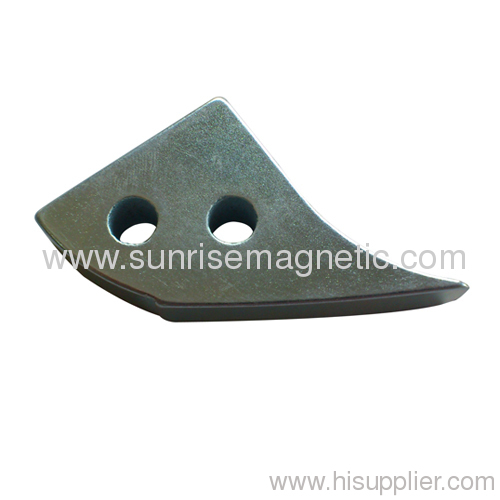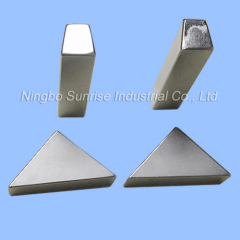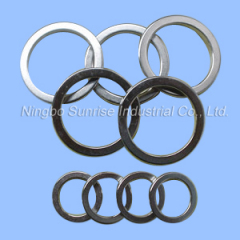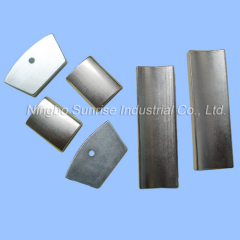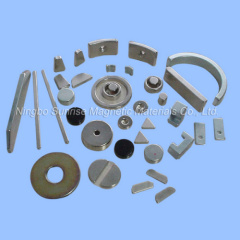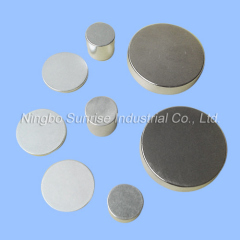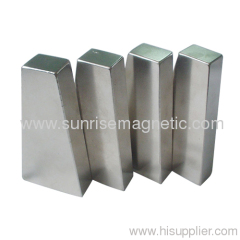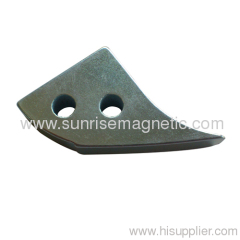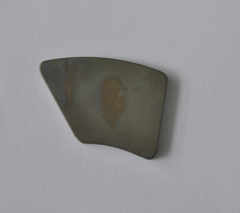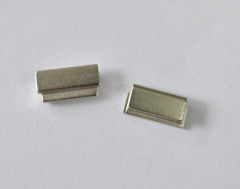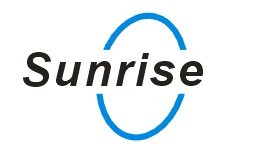
|
Ningbo Sunrise Magnetic Materials Co., Ltd.
|
High performance sintered magnet
| Payment Terms: | T/T |
| Place of Origin: | Zhejiang, China (Mainland) |
|
|
|
| Add to My Favorites | |
| HiSupplier Escrow |
Product Detail
Irregular shape magnet with two holes
The moderate temperature stablity,their working stability is under 80 degree centigrade for low Hci for NdFeB
1.Name: Irregular Shape NdFeB magnet.
4. Grade:Our standard NdFeB is rated to +80 deg C. We offer the whole grade range of Neodymium Iron Boron magnets, with Maximum Energy Product (BHmax) ratings from 30 MGOe to 53 MGOe (N33 to N52) and with a maximum operating temperature rating ranging from +60/+80 deg C to +220/+230 deg C .The complete standard corrosion resistance range of grades isThe Grade:From N33-N52,N33M-N50M,N33H-N48H,N35SH-N45SH,N30UH-N40UH,N30EH-N38EH.Also we can suggest the grade according to where the magnets will be used according to our customer's request.
5. The Excellent strength value:the highest (BH)max reaches up to 53MGOe.
6. The Extremely Resistance to demagnetization with Hci,the intrinsic coercive force is over 30000Oe.Neodymium magnets lose -0.09~-0.13% of Br/°C and -0.05~~-0.08% of Hcj/°C
7.Effective Surface treatment to prevent corrosion,Nickel-Copper-Nickel (Ni-Cu-Ni) [standard], Epoxy, Zinc (Zn), Gold (Au), Silver (Ag), Tin (Sn), Titanium (Ti), Titanium Nitride (TiN), Parylene C, Everlube, Chrome, PTFE ("Teflon"; white, black, grey, silvery) , Ni-Cu-Ni plus Epoxy, Ni-Cu-Ni plus Rubber, Zn plus Rubber, Ni-Cu-Ni plus Parylene C, Ni-Cu-Ni plus PTFE, Tin (Sn) plus Parylene C, Zinc Chromate, Phosphate Passivation and Uncoated (i.e. bare – not recommended but is sometimes required by the customer). Other coatings may be possible - please let us know your requirements.
8.Various shapes and sizes or according to customers's request;Also we can design the size for our customer's request.
9.Widely used in different applications,such as sensors,Motors,rotors,wind turbines/wind generators,loudspeakers,magnetic hooks,magnetic holder,filters automobiles and so on.The Neodymium Iron Boron (NdFeB) magnets were developed just over 25 years ago and were first commercially available in 1984. Neodymium magnets were initially developed for voice coil motors in computer hard disk drives and this market still accounts for over 50 percent of all Neodymium magnets produced. Other applications include high performance motors, brushless DC motors, generators, magnetic separation, magnetic resonance imaging, sensors and loudspeakers. They are becoming increasingly popular across a wide range of novelty products such as fridge magnets and all kinds of magnetically attachable gadgets for retail markets.
2. Material:Sintered Neodymium-Iron-Boron.
3. Advanced techniques: Utilizes new SinteredNdFeB magnet techniques and equipment such as strip casting,HDDR technology in our factory to allow us to make high performance NdFeB over N52 possible.
4. Grade:Our standard NdFeB is rated to +80 deg C. We offer the whole grade range of Neodymium Iron Boron magnets, with Maximum Energy Product (BHmax) ratings from 30 MGOe to 53 MGOe (N33 to N52) and with a maximum operating temperature rating ranging from +60/+80 deg C to +220/+230 deg C .The complete standard corrosion resistance range of grades isThe Grade:From N33-N52,N33M-N50M,N33H-N48H,N35SH-N45SH,N30UH-N40UH,N30EH-N38EH.Also we can suggest the grade according to where the magnets will be used according to our customer's request.
5. The Excellent strength value:the highest (BH)max reaches up to 53MGOe.
6. The Extremely Resistance to demagnetization with Hci,the intrinsic coercive force is over 30000Oe.Neodymium magnets lose -0.09~-0.13% of Br/°C and -0.05~~-0.08% of Hcj/°C
7.Effective Surface treatment to prevent corrosion,Nickel-Copper-Nickel (Ni-Cu-Ni) [standard], Epoxy, Zinc (Zn), Gold (Au), Silver (Ag), Tin (Sn), Titanium (Ti), Titanium Nitride (TiN), Parylene C, Everlube, Chrome, PTFE ("Teflon"; white, black, grey, silvery) , Ni-Cu-Ni plus Epoxy, Ni-Cu-Ni plus Rubber, Zn plus Rubber, Ni-Cu-Ni plus Parylene C, Ni-Cu-Ni plus PTFE, Tin (Sn) plus Parylene C, Zinc Chromate, Phosphate Passivation and Uncoated (i.e. bare – not recommended but is sometimes required by the customer). Other coatings may be possible - please let us know your requirements.
8.Various shapes and sizes or according to customers's request;Also we can design the size for our customer's request.
9.Widely used in different applications,such as sensors,Motors,rotors,wind turbines/wind generators,loudspeakers,magnetic hooks,magnetic holder,filters automobiles and so on.The Neodymium Iron Boron (NdFeB) magnets were developed just over 25 years ago and were first commercially available in 1984. Neodymium magnets were initially developed for voice coil motors in computer hard disk drives and this market still accounts for over 50 percent of all Neodymium magnets produced. Other applications include high performance motors, brushless DC motors, generators, magnetic separation, magnetic resonance imaging, sensors and loudspeakers. They are becoming increasingly popular across a wide range of novelty products such as fridge magnets and all kinds of magnetically attachable gadgets for retail markets.
Didn't find what you're looking for?
Post Buying Lead or contact
HiSupplier Customer Service Center
for help!
Related Search
Sintered Magnet
High Performance Butterfly Valve
Sintered Ndfeb Magnet
Sintered Alnico Magnet
Block Sintered Ndfeb Magnet
Sintered Neodymium Magnet
More>>

